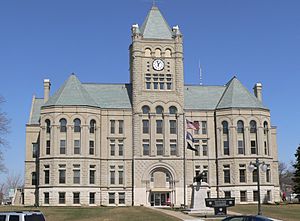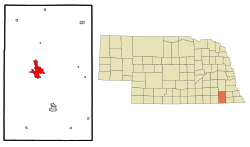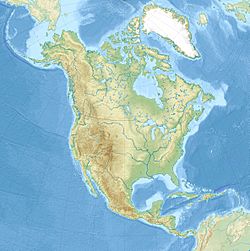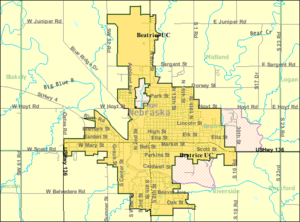Beatrice, Nebraska facts for kids
Quick facts for kids
Beatrice, Nebraska
|
|
|---|---|

Gage County Courthouse
|
|
 |
|
| Country | |
| State | |
| County | Gage |
| Government | |
| • Type | Mayor-council government |
| Area | |
| • Total | 9.48 sq mi (24.55 km2) |
| • Land | 9.39 sq mi (24.33 km2) |
| • Water | 0.09 sq mi (0.22 km2) |
| Elevation | 1,286 ft (392 m) |
| Population
(2010)
|
|
| • Total | 12,459 |
| • Estimate
(2019)
|
12,279 |
| • Density | 1,307.25/sq mi (504.73/km2) |
| Time zone | UTC-6 (Central (CST)) |
| • Summer (DST) | UTC-5 (CDT) |
| ZIP code |
68310
|
| Area code(s) | 402 |
| FIPS code | 31-03390 |
| GNIS feature ID | 0827241 |
| U.S. Routes | |
| Website | beatrice.ne.gov |
Beatrice is a city in and the county seat of Gage County, Nebraska, United States. Its population was 12,459 at the 2010 census. Beatrice is located 40 miles (64 km) south of Lincoln on the Big Blue River and is surrounded by agricultural country.
Contents
History
Gage County was one of the 19 counties originally established by the Nebraska Territorial Legislature in 1854. At the time of its establishment, there were no settlers living within it.
In 1857, the steamboat Hannibal, carrying 300 passengers up the Missouri River from St. Louis, Missouri to Nebraska City, Nebraska, ran aground near Kansas City, Missouri. While it was stranded, 35 of the passengers agreed to form the "Nebraska Association", under which name they would unite in seeking a townsite and establishing a settlement in the territory.
After reaching Nebraska City, the Association divided itself into two exploratory parties, one of which went directly westward and the other southwest. The latter party located the site of Beatrice, at the point where the DeRoin Trail crossed the Big Blue River; and the whole Association decided to settle there. The settlement was named after Julia Beatrice Kinney, the 17-year-old daughter of Judge John F. Kinney, a member of the Association.
The Territorial Legislature selected Beatrice as the county seat of Gage County in 1857. The decision was challenged by Blue Springs, but was confirmed by the Legislature in 1859. In 1864, the Legislature dissolved the original Clay County (not the current Clay County, Nebraska), dividing its land between Gage and Lancaster Counties. The addition of this ground in the north placed Beatrice near the center of the enlarged county, strengthening its claim to the county seat. It continues to hold that position today.
Homestead Act
In 1862, the U.S. Congress passed the Homestead Act, which allowed settlers to claim 160 acres (65 ha) of government land for a nominal fee. The law went into effect on January 1, 1863. Just after midnight on that day, Daniel Freeman persuaded a clerk to open the local Land Office so that he could file a claim for a homestead located 4 miles (6 km) west of Beatrice. His is regarded as the first of the 417 applications filed that day.
In 1936, Congress created Homestead National Monument of America on the site of Freeman's claim.
Early development
The Big Blue River was both a help and a hindrance to the development of Beatrice. It provided the town with a water source, and produced ample power to operate the mills that were among the town's first industries. However, it represented a major obstacle to travelers on the Oregon Trail route; and floods frequently destroyed the dams and bridges in the area. Not until 1890 was a Big Blue bridge built in Beatrice that could survive for decades.
In 1871, the Burlington and Missouri River Railroad constructed a line from Lincoln, Nebraska to Beatrice. In 1879, the Union Pacific Railroad built a line joining Beatrice to Marysville, Kansas. By 1890, the Chicago, Rock Island and Pacific Railroad had also run tracks through Beatrice.
Beatrice State Developmental Center
In 1885, the Nebraska legislature enacted legislation to establish the Institution for Feeble Minded Youth near Beatrice, subject to the city's donating a suitable parcel of land. Beatrice donated 40 acres, located 2 miles (3 km) east of the city limits; and the first residents were admitted in 1887.
Over the following decades, the institution expanded greatly. By 1935, there were 1171 residents living on 519 acres (210 ha). The institution was largely self-supporting, operating a farm on which the residents did much of the work; in 1935, 346 acres (140 ha) were under cultivation.
In 1945, the institution was renamed the Beatrice State Home. Its resident population peaked at about 2300 in the late 1960s. From there it declined: new restrictions had been imposed on the use of unpaid labor by residents of institutions, and there was a national trend toward deinstitutionalization. In 1975, the Horacek v. Exon lawsuit was settled with a consent decree whereunder many of the residents of the Beatrice State Home were transferred to community-based mental health facilities. In that year, the institution's name was changed to the current Beatrice State Developmental Center.
A 2006 investigation by the federal Centers for Medicare and Medicaid Services revealed a number of severe deficiencies at the Center; after two years of appeals, the Center lost its Medicaid certification in 2009.
As of 2011, the Center served about 175 clients. The majority had been diagnosed with "severe" or "profound" retardation; nearly all suffered from two or more other disabling conditions.
Geography
Beatrice is located at 40°16′6″N 96°44′35″W / 40.26833°N 96.74306°W (40.268449, -96.743192). According to the United States Census Bureau, the city has a total area of 9.11 square miles (23.59 km2), of which, 9.02 square miles (23.36 km2) is land and 0.09 square miles (0.23 km2) is water.
Demographics
| Historical population | |||
|---|---|---|---|
| Census | Pop. | %± | |
| 1880 | 2,447 | — | |
| 1890 | 13,836 | 465.4% | |
| 1900 | 7,875 | −43.1% | |
| 1910 | 9,356 | 18.8% | |
| 1920 | 9,664 | 3.3% | |
| 1930 | 10,297 | 6.6% | |
| 1940 | 10,883 | 5.7% | |
| 1950 | 11,813 | 8.5% | |
| 1960 | 12,132 | 2.7% | |
| 1970 | 12,389 | 2.1% | |
| 1980 | 12,891 | 4.1% | |
| 1990 | 12,354 | −4.2% | |
| 2000 | 12,496 | 1.1% | |
| 2010 | 12,459 | −0.3% | |
| 2019 (est.) | 12,279 | −1.4% | |
| U.S. Decennial Census | |||
2010 census
As of the census of 2010, there were 12,459 people, 5,509 households, and 3,296 families living in the city. The population density was 1,381.3 inhabitants per square mile (533.3/km2). There were 6,075 housing units at an average density of 673.5 per square mile (260.0/km2). The racial makeup of the city was 96.1% White, 0.5% African American, 0.5% Native American, 0.6% Asian, 0.7% from other races, and 1.6% from two or more races. Hispanic or Latino people of any race were 2.2% of the population.
There were 5,509 households, of which 27.6% had children under the age of 18 living with them, 44.9% were married couples living together, 10.7% had a female householder with no husband present, 4.2% had a male householder with no wife present, and 40.2% were non-families. 34.5% of all households were made up of individuals, and 16.5% had someone living alone who was 65 years of age or older. The average household size was 2.23 and the average family size was 2.82.
The median age in the city was 42.6 years. 22.6% of residents were under the age of 18; 8.2% were between the ages of 18 and 24; 22% were from 25 to 44; 26.8% were from 45 to 64; and 20.4% were 65 years of age or older. The gender makeup of the city was 47.8% male and 52.2% female.
Area attractions
- Beatrice Speedway
- Gage County Museum, housed in the 1906 Burlington Railroad Depot and operated by the Gage County Historical Society
- Homestead National Monument of America
- Homestead Trail
- Community Players Theatre
In popular culture
Beatrice is the setting for The Gallows, a 2015 found footage movie that was co-written, co-directed and co-produced by Chris Lofing, a graduate of Beatrice High School.
A popular story was circulated about a near-miss that occurred in Beatrice, when, at 7:25 pm on March 1, 1950, a church exploded five minutes after the scheduled choir practice, but no one was injured because all fifteen members were late. Snopes.com identified this as a true event.
Notable people
- George D. Baker (1868–1933), motion picture director of the silent film era
- Eudora Stone Bumstead (1860–1892), poet, hymnwriter
- Clara Bewick Colby (1846–1916), author
- Gene L. Coon (1924–1973), screenwriter and television producer
- Jim Faulkner (1899–1962), baseball player
- John P. Fulton (1902–1966), special effects supervisor and cinematographer
- Jim Gillette (b. 1967), glam metal rock musician and lead singer, most notably with Nitro
- Homestead Harmonizers, chorus formed in 1988
- Peter Jansen (1852–1923), sheep rancher, Nebraska state representative and senator
- Weldon Kees (1914–1955), poet, critic, novelist, and short story writer
- Oliver Kirk (1884–1960), won two gold medals in boxing at the 1904 Summer Olympics
- Lou Ann Linehan (b. 1955), member of Nebraska Legislature
- Kevin Meyer (b. 1956), Lieutenant Governor of Alaska
- Xavier Omon (b. 1985), NFL football player
- Algernon Paddock (1830–1897), U.S. Senator from Nebraska
- Pid Purdy (1904–1951), athlete who played both Major League Baseball and National league football
- Janet Shaw (1919–2001), film actress
- Robert Taylor (1911–1969), film and television actor
- Edward Wight Washburn (1881–1934), chemist
- Dora V. Wheelock (1847–1923), temperance activist and writer
See also
 In Spanish: Beatrice (Nebraska) para niños
In Spanish: Beatrice (Nebraska) para niños





